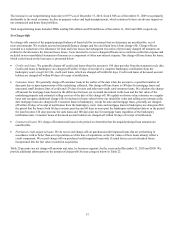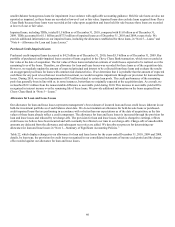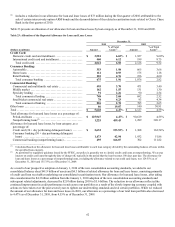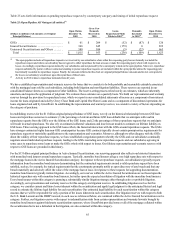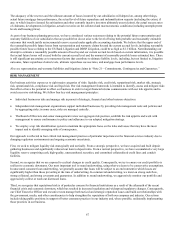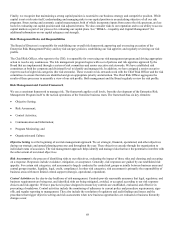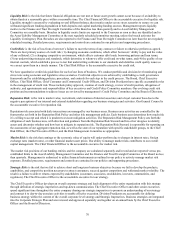Capital One 2010 Annual Report Download - page 87
Download and view the complete annual report
Please find page 87 of the 2010 Capital One annual report below. You can navigate through the pages in the report by either clicking on the pages listed below, or by using the keyword search tool below to find specific information within the annual report.
67
The adequacy of the reserves and the ultimate amount of losses incurred by our subsidiaries will depend on, among other things,
actual future mortgage loan performance, the actual level of future repurchase and indemnification requests (including the extent, if
any, to which Inactive Insured Securitizations and other currently inactive investors ultimately assert claims), the actual success rates
of claimants, developments in litigation, actual recoveries on the collateral and macroeconomic conditions (including unemployment
levels and housing prices).
As part of our business planning processes, we have considered various outcomes relating to the potential future representation and
warranty liabilities of our subsidiaries that are possible but do not arise to the level of being both probable and reasonably estimable
outcomes that would justify an incremental reserve accrual under applicable accounting standards. We believe that the upper end of
the reasonably possible future losses from representation and warranty claims beyond the current accrual levels, including reasonably
possible future losses relating to the US Bank Litigation and DBSP Litigation, could be as high as $1.1 billion. Notwithstanding our
attempt to estimate a reasonably possible amount of loss beyond our current accrual levels based on current information, it is possible
that actual future losses will exceed both the current accrual level and the amount of reasonably possible losses estimated here. There
is still significant uncertainty as to numerous factors that contribute to ultimate liability levels, including, but not limited to, litigation
outcomes, future repurchase claims levels, ultimate repurchase success rates, and mortgage loan performance levels.
Also see representation and warranty liabilities and litigation claims in “Note 21—Commitments, Contingencies and Guarantees.”
RISK MANAGEMENT
Our business activities expose us to eight major categories of risks: liquidity risk, credit risk, reputational risk, market risk, strategic
risk, operational risk, compliance risk and legal risk. Our risk management framework is intended to identify, assess and mitigate risks
that affect or have the potential to affect our business in order to target financial returns commensurate with our risk appetite and to
avoid excessive risk-taking. We follow four key risk management principles:
• Individual businesses take and manage risk in pursuit of strategic, financial and other business objectives.
• Independent risk management organizations support individual businesses by providing risk management tools and policies and
by aggregating risks; in some cases, risks are managed centrally.
• The Board of Directors and senior management review our aggregate risk position, establish the risk appetite and work with
management to ensure conformance to policy and adherence to our adopted mitigation strategy.
• We employ a top risk identification system to maintain the appropriate focus on the risks and issues that may have the most
impact and to identify emerging risks of consequence.
Our approach is reflected in four critical risk management practices of particular importance in the financial services industry due to
changing regulatory environments and ongoing economic uncertainty.
First, we seek to mitigate liquidity risk strategically and tactically. From a strategic perspective, we have acquired and built deposit
gathering businesses and significantly reduced our loan to deposit ratio. From a tactical perspective, we have accumulated a very large
liquidity reserve comprising cash, high-quality, unencumbered securities, and committed collateralized credit lines and conduit
facilities.
Second, we recognize that we are exposed to cyclical changes in credit quality. Consequently, we try to ensure our credit portfolio is
resilient to economic downturns. Our most important tool is sound underwriting, using what we deem to be conservative assumptions.
In unsecured consumer loan underwriting, we generally assume that loans will be subject to an environment in which losses are
significantly higher than those prevailing at the time of underwriting. In commercial underwriting, we insist on strong cash flow,
strong collateral, and strong covenants and guarantees. In addition to sound underwriting, we aggressively monitor our portfolio and
aggressively collect or work out distressed loans.
Third, we recognize that reputational risk is of particular concern for financial institutions as a result of the aftermath of the recent
financial crisis and economic downturn, which has resulted in increased regulation and widespread regulatory changes. Consequently,
our Chief Executive Officer and executive team manage both tactical and strategic reputation issues and build our relationships with
the government, media, and other constituencies to help strengthen the reputations of both our company and industry. Our actions
include taking public positions in support of better consumer practices in our industry and, where possible, unilaterally implementing
those practices in our business.


